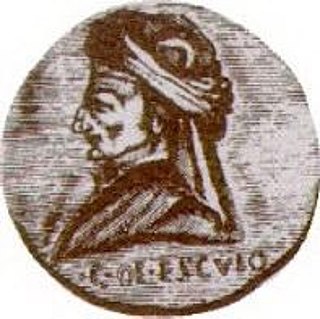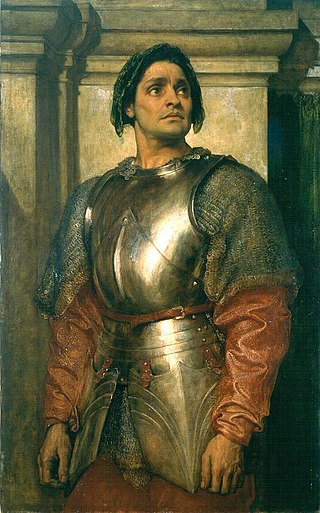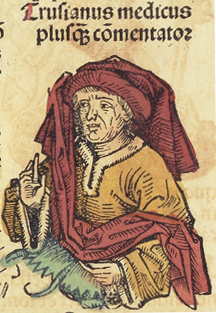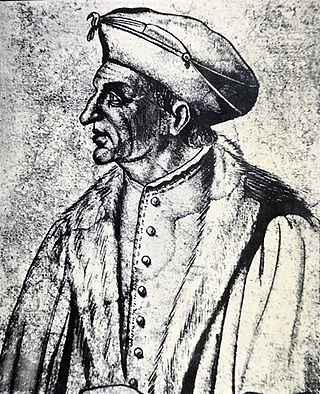Life
He was the son of a physician and surgeon Bono del Garbo from the wealthy noble Del Garbo family in Florence. In 1295 he was a pupil of Taddeo Alderotti in Bologna, then one of the most important representatives of a reorientation of medicine and natural philosophy using the works of Averroes and Avicenna, to which Dino del Garbo also made a major contribution.
In 1296 he returned to his father in Florence due to the war between Bologna and Ferrara and until 1297 was enrolled alongside his father in the Florence guild of physicians and pharmacists. In 1300 the political conditions improved enough for him to resume his studies in Bologna, where he received his doctorate in the following years and taught from 1304 to 1306. When the papal legate Napoleone Orsini Frangipani excommunicated Bologna in 1306 and thus excluded the citizens of Bologna from attending the university, Dino del Garbo was once again forced to leave Bologna. Already in October 1306 he was in the municipality of Siena, on the unusually high salary of 90 gold florins as a "dotore del chomune di Siena in scienza e fisicha". He taught in Siena until spring 1309 and it was there where he completed his commentary on part of book IV of the Canon by Avicenna.
He then returned to Bologna and in 1311 began his Dilucidatorium totius pratice medicinalis scientie, a commentary on part of Book I of the Canon. After several years of teaching in Padua, in 1319 he returned to Florence and there completed his Dilucidarium. In 1321, in the wake of the Medicine and Arts Faculties' exodus from Bologna to Siena, he was re-appointed by the municipality of Siena, this time at an exorbitant annual salary of 350 gold florins. He taught in Siena until 1323 and during this time worked on his commentary on treatment using medicinal plants in book II of Avicenna's Canon, a work which he completed in 1325 after returning to Florence and which he dedicated to Robert of Anjou. He also produced a Latin commentary on Guido Cavalcanti's love poem Donna me prega, possibly during these final years in Florence - it is preserved in a manuscript of Boccaccio and was translated to an extended vernacular version.
In Giovanni Villani's chronicle (X.41) it is stated that del Garbo was involved in the persecution and execution of Cecco d'Ascoli due to earlier accusations of plagiarism, though this involvement is now questioned. Del Garbo died soon after Cecco's execution and this was later legendarily attributed to a spell of revenge cast by Cecco. His son Tommaso del Garbo was also a doctor.

Baldus de Ubaldis was an Italian jurist, and a leading figure in Medieval Roman Law and the school of Postglossators.

Cecco d'Ascoli is the popular name of Francesco degli Stabili, an Italian encyclopaedist, physician and poet. Cecco is the diminutive of Francesco, Ascoli was the place of his birth. The lunar crater Cichus is named after him.
Peter, called Tempesta, was the Count of Eboli from 1306. He was the eighth son of Charles II of Naples and Maria of Hungary. His sobriquet came from his stormy temperament.
Azzo VIII d'Este was lord of Ferrara, Modena and Reggio from 1293 until his death.
Lawrence Torrentinus, also known as Lorenzo Torrentino, Laurentius Torrentinus, Laurens van den Bleeck (1499–1563) was a Dutch-Italian humanist and famous typographer and printer for Cosimo I de' Medici, Duke of Florence

Gentile Gentili da Foligno was an Italian professor and doctor of medicine, trained at Padua and the University of Bologna, and teaching probably first at Bologna, then at the University of Perugia, Siena (1322–1324), where his annual stipend was 60 gold florins; he was called to Padua (1325–1335) by Ubertino I da Carrara, Lord of Padua, then returned to Perugia for the remainder of his career. He was among the first European physicians to perform a dissection on a human being (1341), a practice that had long been taboo in Roman times. Gentile wrote several widely copied and read texts and commentaries, notably his massive commentary covering all five books of the Canon of Medicine by the 11th-century Persian polymath Avicenna, the comprehensive encyclopedia that, in Latin translation, was fundamental to medieval medicine. Long after his death, Gentile da Foligno was remembered in the Nuremberg Chronicle (1493) as Subtilissimus rimator verborum Avicenne, "that most subtle investigator of Avicenna's teachings"

Cante dei Gabrielli di Gubbio was an Italian nobleman and condottiero.

Turisanus de Turisanis was the Latin name of Pietro Torrigiano de' Torrigiani, a theoretical physician from a well-known Florentine family who taught medicine in Paris, c. 1305–19, and wrote an elaborated and influential series of commentaries on Galen's Microtechni, Plusquam commentum in Microtechni Galenii and a shorter De hypostasi urine Galeni. The two commentaries, all that survives of Torrigiani's output, were printed together by Ugo Rugerius in 1489, and in several later editions, both incunabula and 16th-century printings. The work took the conventional form of the set of quaestiones disputatae familiar in Scholasticism.

Cecco di Pietro was an Italian painter of the Pisan School. While his date of birth cannot be confirmed, there is some mention of a Cecco Pierri working with the painter Paolo di Lazzarino in 1350. If this was a reference to di Pietro, then his date of birth can be placed around 1330.

Giovanni Rucellai, known as Giovanni di Bernardo Rucellai, was an Italian humanist, poet, dramatist and man of letters in Renaissance Florence, in Tuscany, Italy. A member of a wealthy family of wool merchants and one of the richest men in Florence, he was cousin to Pope Leo X and linked by marriage to the powerful Strozzi and de' Medici families. He was born in Florence, and died in Rome. He was the son of Bernardo Rucellai (1448–1514) and his wife Nannina de' Medici (1448–1493), and the grandson of Giovanni di Paolo Rucellai (1403–1481). He is now remembered mostly for his poem Le Api, one of the first poems composed in versi sciolti to achieve widespread acclaim.

Taddeo Alderotti, born in Florence between 1206 and 1215, died in 1295, was an Italian doctor and professor of medicine at the University of Bologna, who made important contributions to the renaissance of learned medicine in Europe during the High Middle Ages. He was among the first to organize a medical lecture at the university.
Andrea Alpago was an Italian physician and arabist. In publications of his work in Latin, his name is frequently given as Andreas Alpagus Bellunensis, where "Bellunensis" refers to his birthplace of Belluno in northeastern Italy.

Lucantonio Giunti or Giunta was a Florentine book publisher and printer, active in Venice from 1489, a member of the Giunti family of printers. His publishing business was successful, and among the most important in the late fifteenth and early sixteenth centuries. Through partnerships, often with members of his family, he expanded the business through much of Europe. At about the time of his death in 1538 there were Giunti presses in Florence and Lyon, Giunti bookshops or warehouses in Antwerp, Burgos, Frankfurt, Lisbon, Medina del Campo, Paris, Salamanca and Zaragoza, and agencies in numerous cities of the Italian peninsula, including Bologna, Brescia, Genoa, Livorno, Lucca, Naples, Piacenza, Pisa, Rome, Siena and Turin, as well as the islands of Sardinia and Sicily.
Tommaso del Garbo or Thomas de Garbo was a professor of medicine in Perugia and Bologna. He was the son of the physician Dino del Garbo and a friend of the poet Petrarch. It is said that the physician Pietro da Tossignano studied under Garbo at the University of Bologna.

Giovanni Manardo was an Italian physician, botanist, and humanist.
Orazio Bacci was an Italian Liberal Party politician. He was the 12th mayor of Florence, Kingdom of Italy. He died in Rome.

Alessandro Felici was an Italian composer and violinist, not to be confused with his contemporary, Roman composer Felice Alessandri.
Pietro da Tossignano also known as Pietro Curialti was a professor of medicine in Perugia and Bologna.

Domenico Giuliotti was an Italian writer and essayist. He was a dedicated Catholic and his rigidity and severity are reflected in his numerous works.












